Picture Pages: Devin Gardner's Near Interception Pity Party

SITE NOTE: due to this taking longer than I wanted it to and triple OT, UFR will be in the evening today.
Devin Gardner threw many passes that hit Northwestern defenders on Saturday, a good number of them I CAN'T BELIEVE HE DROPPED THAT interceptions. There were moments when I was going over the game where it seemed like it wasn't really all that bad because of thing X or thing Y, and then moments where it was very, very bad. So I thought I'd pull this out of a larger UFR discussion and try to evaluate just what happened on the various passes on which Gardner's throws hit Northwestern players.
Normally I wouldn't put batted passes in here, but there were a few incidents where batted passes were the only thing separating Northwestern from yet another pass that hit them in the hands and was inexplicably dropped, so they are also added.
Category #1: Understandable Items
#1: Gardner gets a heavy rush due to a bad blitz pickup, escapes it, and tries to throw late to a covered Devin Funchess; ball gets batted down at the line.
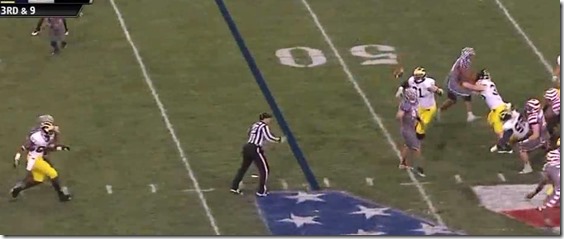
That's probably a PBU at worst, and he's under heavy duress.
#2: Michigan botches a freeze play when Northwestern jumps but does not cross the line. Gardner thinks he's got a free play and tries a back shoulder fade to Gallon that could be farther outside; it's a nice play by a DB who seems totally bailed out to come back to the ball and a poor one by Gallon not to break this off sooner once he perceives the DB is way over the top. The DB actually reads this obvious back shoulder opportunity before he does; he should be breaking back so that he gets to the ball before the DB.
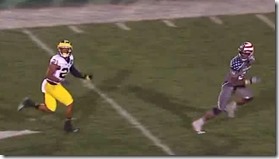
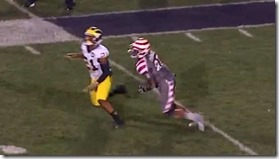
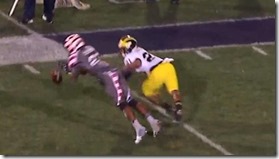
#3: Third down rollout on the next play sees no one open. Gardner tries to fit it in to Dileo anyway, and leaves it a little inside of where it should be. Gardner's about to be hammered and goes for it.
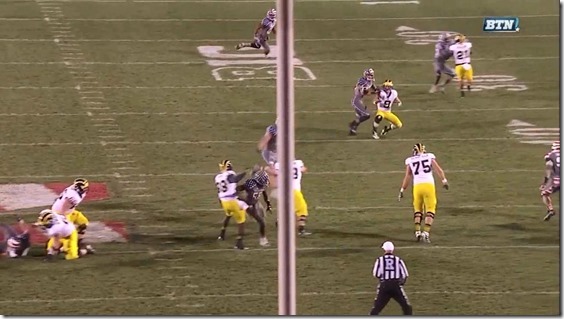
This wasn't really close to an INT and you might as well try for the first down.
Category #2: Death-Defying Really Bad Ideas
#1: The first incident of this variety happens three minutes into the second quarter. Gardner drops back, pump-fakes a slant to Funchess, and then throws it.
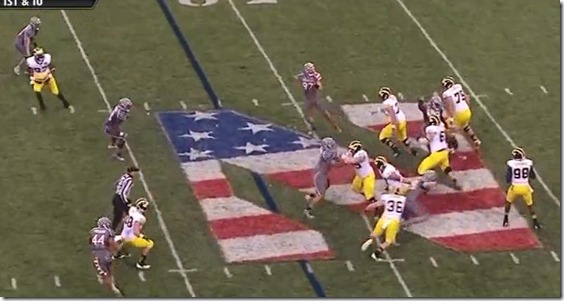
He does get pressure from another crappy slide protection on which Lewan ignores a DE, and unless Gallon is open deeper to the outside the best case scenario here is a sack if he does not throw the ball. That was the move.
#2: Gardner bobbles a snap on third and three and comes up firing a wheel route that NW jumps and is thinking pick six on; they blitzed and left Jake Butt screamingly wide open.
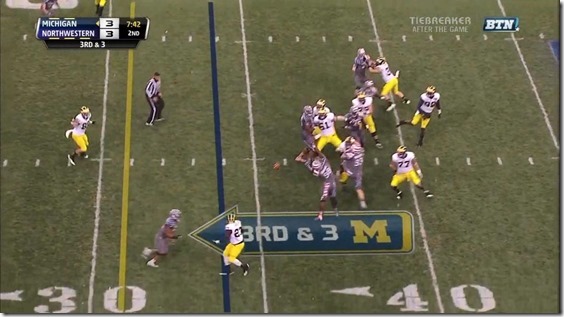
The snap bobble takes Gardner's eyes off the defense and contributes here. Still: turrible.
#3: Michigan fortunate to have a slant batted down at the line as Northwestern undercuts whatever Gardner is looking at, in fact with two guys in Butt's case.
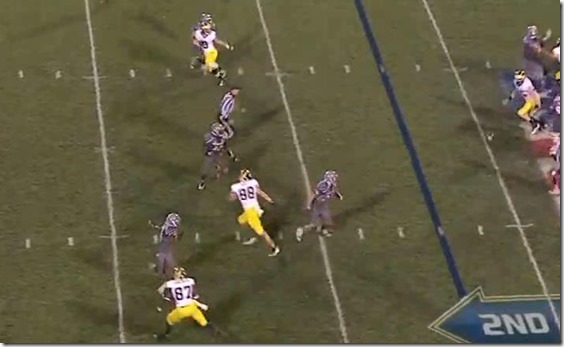
Gardner had Gallon as an option on the other side of the field.
[After the JUMP: another category, and evaluation.]
Category #3: Guys Popping Up In Bad Places
One of the themes of the day was Northwestern dumping guys into areas they expected Michigan to throw and getting those throws, often because Michigan had few other options. You may remember that a bunch of throws to Jeremy Gallon seemed scary because they had to get over a defender, and that's because Northwestern was dropping an end to his side on play after play.
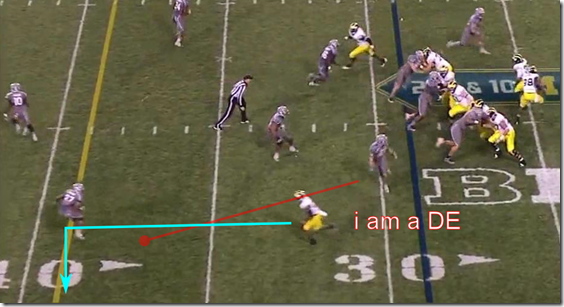
This was mostly just scary, as that DE ended up about six inches from batting the ball three or four times. I know that OCs hate it when you throw over dropping defenders, because the windows there are small and the result if you miss it is the sort of PBU that flutters into the air for the rest of the secondary to pounce on, but on a lot of these throws Gardner had no better options.
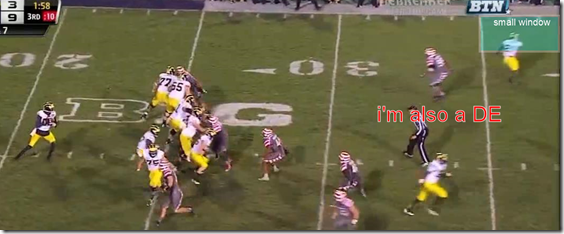
The first play here was a Gallon drop, the second a completion.
This one was another pass batted at the line that Michigan was fortunate to get away with:
This is a bad read, too, but I have sympathy for Gardner as Northwestern is clearly sitting on this exact thing and gets it.
Again, options there are Gallon or Funchess not particularly open or thing Michigan does all the time and Northwestern is hoping they will do. On the next third down a similar thing happens, as Michigan rolls the pocket hoping for a comeback route to Chesson and NW just runs a guy under it.
This is a terrible decision on which his best option is to throw the ball out of bounds and set up fourth and four, which is a terrible option when you have a minute left and are down three points.
At least he didn't throw this pop pass on which Northwestern is waiting to have the ball clang off their hands.
Excelsior!
Conclusions
It wasn't as bad as it looked because it was worse. Gardner had two or three balls knocked down at the line that were headed for at least PBUs and possibly interceptions if anyone on Northwestern had been familiarized with the idea of catching a football. And for the most part these were on him. Even if you have nowhere to go, the play is usually to eat the sack and live to fight another day. There were six passes on which Gardner threw into near-INT coverage without a mitigating factor. That is brutal.
Borges really did not help, though. Michigan's first throw over about 15 yards occurred with under a minute left in regulation, that a fly route just over Chesson's head after the rollout sack to put Michigan in second and twenty-three. That was the first time Michigan even looked at one—they didn't try to get some deep throws off only to be thwarted by pressure. It was windy, but it wasn't that windy, especially when you've got this offense.
Like the last two games, Northwestern had several instances where they were basically reading Borges's mind on key plays late. Even most of the completions to Gallon were a foot away from trouble with Northwestern dropping DEs into his area most of the day. Quarterbacks don't usually have the number of opportunities to throw near INTs that Gardner did in this game, and this is against a Northwestern secondary that is not particularly good.
For most of the day, Michigan had nothing with which to respond. They broke Butt to an out route on the pop pass for six yards. That was about it. It wasn't until the last play of the second overtime and first play of the third that he made an adjustment by sending Gallon on open post routes, the first of which was dropped by Gallon, the second of which was winged wide by Gardner. "We didn't execute" is approved in re: those two plays. Better late than never, I guess, but taking 3.5 quarters to adapt usually means your great idea comes on the bus ride home. The rest of the day was spent with hitch after hitch that was dangerous and blanketed pop passes, etc.
![10898327294_ee778119e1_z[1] 10898327294_ee778119e1_z[1]](http://mgoblog.com/sites/mgoblog.com/files/images/Picture-Pages-Devin-Gardners-Near-Interc_90AC/10898327294_ee778119e1_z1.jpg)
Bryan Fuller
The regression question. How much of this is on Michigan not having anyone open versus Gardner not being good at quarterbacking versus Borges not being a great QB coach is unknown. Gardner seems to be regressing, like Denard seemed to regress before him. While there are a lot of reasons Gardner's decision-making is going the wrong direction—most prominently the barbarian waves charging through the offensive line—this is verging on a trend.
Is there a counter-trend in Borges's career? Unfortunately, he's bounced around so much that it's almost impossible to get a read on whether he can develop a quarterback. The only extended stints in his career were from 1996 to 2000 at UCLA and 2004 to 2007 at Auburn.
At UCLA, Borges had Cade McNown, who went from an INT-mad sophomore with a 52% completion rate to a 10 YPA, 3 TD : 1 INT guy his last two years. After McNown left, three UCLA QBs combined to have a miserable year in 1999, with freshman Cory Paus becoming the starter and putting up 6.8 yards an attempt on under 50% completions. Paus got better the year after with a 9.0 YPA, ok TD/INT ratio, and 56% completion percentage, whereupon Bob Toledo got broomed. Paus was basically the same player under the new regime. Complicating matters: Toledo had been UCLA's offensive coordinator the two years before he was promoted, so it's tough to suss out what was Toledo and what was Borges.
At Auburn he was definitely in charge of everything. After one year of Jason Campbell that went very well, Borges had Brandon Cox, who had a degenerative muscle disease and went backwards, finishing his career with his worst YPA (6.6), 9 TDs, and 13 INTs. These are literally the only serious data points we have here, as those are the only stints of his career that have lasted longer than two years other than this one. (Borges has a knack for showing up at places just before the coaching staff gets canned.) Can Borges develop a quarterback? I have no idea. It doesn't help that he had a QB coach at San Diego State who had some hand in developing Ryan Lindley.
November 20th, 2013 at 4:18 PM ^
Anyone would regress behind this blocking. It's awfully hard to be a good QB when you're on your butt every play.
I would actually argue Borges has done a nice job developing DG. Gardner looked terrible as a QB when he arrived at Michigan, and he has become one of our best players, and will probably finish with the second-most passing yards in a season in Michigan history.
Joe Montana wouldn't have looked good behind this line. You can blame Borges for that, but this is not a good year to measure a QB's performance.
November 20th, 2013 at 5:03 PM ^
Northwestern was in cover 3 the vast majority of the time, especially between the 20s. This means they had CBs bailing at the snap, plus a centerfield safety. They often combined that with bringing a 5th pressure, sometimes by utilizing a zone blitz. What this means is that that ~10 yard hitch route toward the sideline is one of the easiest throws, not just because it's in a void that can be attacked against that coverage (it was the same void that Siemian actually found success when Michigan ran cover 3 as well) but also because it simplifies the reads with underneath coverage.
That's not to say that cover 3 can't be exploited with deeper routes. The problem is, there are very few deep routes that are both simple and quick that can be utilized well against that coverage. Quick, simple deep routes include: corner, fade, and skinny post. Fade is tough because the CB is playing well over top of you (which is why DG threw the back shoulder to Gallon), corner is about the worst throw to make, and skinny post was used later in the game, but only after the hitch and out allowed the WR to give a mock-step outside so that he could end up getting inside leverage on CB. Maybe Borges should have gone there sooner, it's difficult to say with that though.
Now, you'll see OSU slaughter Cover 3 when they know Cover 3 is coming. But that's because they have the luxary of running longer developing routes. You can beat cover 3 with a corner-post double move for instance. You can beat Cover 3 with a post-wheel combo to some degree that develops downfield. You can beat Cover 3 with a deep flood where there is a deep cross from the opposite side of the field, a post route from the play side, and a flat receiver to attack the same void Michigan and Northwestern both exploited against Cover 3. So yes, there are things that can be done to exploit Cover 3, but Michigan can't protect long enough to do those things. So what you saw was often a single receiver run something deep. Even on the PA hitch, Funchess typically runs a post or seam, whatever is away from the safety. They do this for when the safety starts sneaking over to help the CB so that the CB can play tighter, then they can attack over top. But Northwestern stuck mostly in their cover 3 and didn't do that, so the hitches kept coming.
Unfortunately, with this OL and Gardner struggling to read underneath coverage, you're stuck trying to take the small things that Northwestern is giving you short/intermediate the outside. Until the OL can protect long enough to develop some deeper routes, therefore opening up the underneath stuff and all the chaos, and therefore run the football, it's going to be this way. They are stuck doing some limited stuff because it all comes back to the inability of the OL to pass protect and consistently run block. Call me an apologist I guess.
November 20th, 2013 at 5:40 PM ^
i am one of borges' biggest critics but i thought he called a solid game against NW; short passes, screens and that new draw play...until he got to the redzone. i thought his playcalling inside the NW 20 was terrible.
November 20th, 2013 at 5:50 PM ^
I think the issue in the red zone is that those CBs no longer have to really drop. So, despite not being good in tight coverage, they can essentially play tight because there are limited ways of beating them. That's a big reason why they bogged down in the red zone I believe.
FWIW, and maybe Borges should have gone to it earlier, but the FB flat and the pass to Butt for a TD were the same play. Because the run was working, the LB that is responsible for covering the flat was staying momentarily longer on the run. This put the CB in a bind, cover the 5 yard flat or stay on the TE running the corner route (corner flattens to an out against cover 3 generally). Well, the first time he ran with Butt. The second time he got caught in no man's land playing neither really and Butt scored a TD. But that's something that's completely set up by the run game and isn't available otherwise.
November 20th, 2013 at 6:01 PM ^
I think he's done this each week so far, as in trying to attack in the best ways for the majority of the coverage.
MSU - Cover 4 - MSU runs their cover 4 a lot like a cover 0 with their safety heavily involved in coverage rather than as an alley defender. They also play press. So you stack your receivers so you can dictate how/who they cover and they can't affect your timing. You stem your routes and run some double moves so that they are forced to cover the whole field rather than pin you to the sideline or dictate your opening. Problem is this takes time to develop and they are keeping a LB in the middle even when they are blitzing, and sealing anything to the middle with their OLBs otherwise. So they are caught in a bind that is brought down by a lack of protection.
Nebraska - Cover 1 - You beat cover 1 with short/intermediate routes to all areas of the field. Problem is you can't run. This means the LBs aren't commiting to the run meaning there is a lot of wash underneath making it hard to throw anything to the middle of the field. The CBs are playing tight and you're not given much time to throw, so you can't run them off or beat them with double moves. So you run a lot of bunch and stack stuff or mesh concepts to rub off defenders in an effort to to guys open against the man coverage. This is what Borges tried to do. But again, pressure and a lack of run game.
Northwestern - Cover 3 - As I described above.
So, while this seems like I'm being an apologist again, as far as the passing game, Borges is trying to do what he can under the constraints he has. He's trying to get even a little bit of a run game going against the teams just so he can expand his play book even marginally (like he was successful doing against Northwestern). I said at one point in a preview of the Northwestern game that Michigan is going to throw a lot of short and intermediate passes, and it's not because Borges suddenly gets it. It's because Northwestern doesn't play tight on the outside and goes to a lot of cover 3.
So I get when some people complain about the run game. I understand that people don't want so much of everything, and have explained my feelings on that along with what I believe their reasons have been for doing so. I would also like some constraints but in many ways the actual play is successful enough to go to the constraint and in other ways some of the constraint plays either take too long to develop, they don't have the personnel, or they throw into the traffic. So I understand some complaints. I understand the frustration with some of the player developement. But all I've ever asked was to look at it from the coaches perspective. And that's why I've based my conclusions off of as far as the problem, and that's seen in Seth's piece. Really, most of the problems come directly back to the OL, and the ones that don't come directly back are still heavily indirectly affected by it. That's how important OL play is.
November 20th, 2013 at 5:17 PM ^
For whatever it's worth, I'm almost certain the passes at the end of the game to Dileo are option routes. This is pretty much the same play that Michigan has been running as far back as PSU (where he ran an out). Dileo either runs an out, hitch, or in based on the CB's leverage. The CB has outside leverage, Dileo breaks in. There is a LB playing the hook zone, that LB reads Gardner's eyes and it takes him directly to the play (rather than holding his eyes on the seam receiver). Gardner doesn't hold the center of the field too well at this point because he's trying to get the ball out quick because he feels pressure quickly and make the correct reads as he's struggling with underneath coverage. It's not really that the LB knew the play that was coming, it's that he's playing his zone and on the replay you see him watch DG's eyes that take him to the throw (and away from the seam threat, which appears to be carried anyway, so this may in fact be a robber zone).
November 20th, 2013 at 7:25 PM ^
Can we have just one main page football article not about Al Borgess?
November 21st, 2013 at 5:11 PM ^
I blame the NW uniforms. Sorta kidding, but I can barely see them on the screen because they're the same shade as the field. I always wonder how opponent uniform camoflage affects QB reading and recognition.
Comments